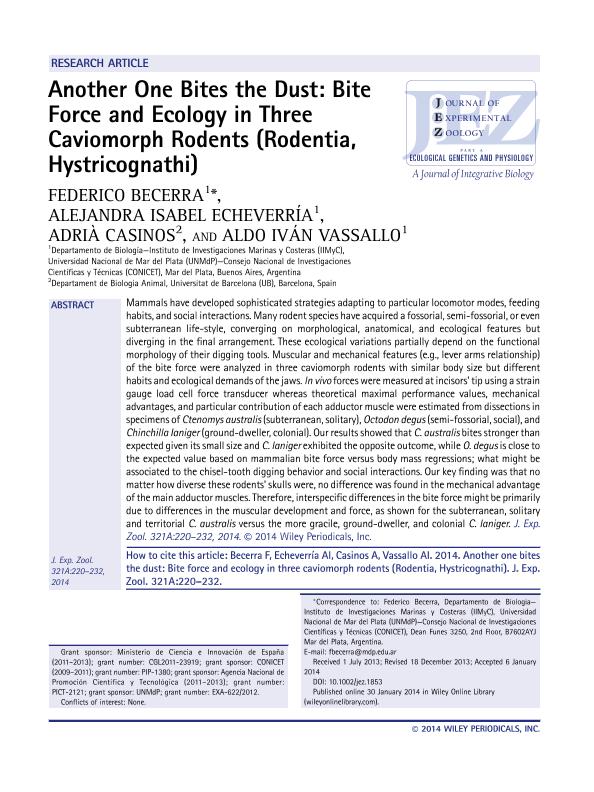Mostrar el registro sencillo del ítem
dc.contributor.author
Becerra, Federico

dc.contributor.author
Echeverría, Alejandra Isabel

dc.contributor.author
Casinos, Adrià
dc.contributor.author
Vassallo, Aldo Iván

dc.date.available
2020-03-25T14:57:35Z
dc.date.issued
2014-06
dc.identifier.citation
Becerra, Federico; Echeverría, Alejandra Isabel; Casinos, Adrià; Vassallo, Aldo Iván; Another one bites the dust: Bite force and ecology in three caviomorph rodents (Rodentia, Hystricognathi); Wiley-liss, Div John Wiley & Sons Inc; Journal of Experimental Zoology Part A: Ecological Genetics and Physiology; 321; 4; 6-2014; 220-232
dc.identifier.issn
1932-5223
dc.identifier.uri
http://hdl.handle.net/11336/100673
dc.description.abstract
Mammals have developed sophisticated strategies adapting to particular locomotor modes, feeding habits, and social interactions. Many rodent species have acquired a fossorial, semi-fossorial, or even subterranean life-style, converging on morphological, anatomical, and ecological features but diverging in the final arrangement. These ecological variations partially depend on the functional morphology of their digging tools. Muscular and mechanical features (e.g., lever arms relationship) of the bite force were analyzed in three caviomorph rodents with similar body size but different habits and ecological demands of the jaws. In vivo forces were measured at incisors' tip using a strain gauge load cell force transducer whereas theoretical maximal performance values, mechanical advantages, and particular contribution of each adductor muscle were estimated from dissections in specimens of Ctenomys australis (subterranean, solitary), Octodon degus (semi-fossorial, social), and Chinchilla laniger (ground-dweller, colonial). Our results showed that C. australis bites stronger than expected given its small size and C. laniger exhibited the opposite outcome, while O. degus is close to the expected value based on mammalian bite force versus body mass regressions; what might be associated to the chisel-tooth digging behavior and social interactions. Our key finding was that no matter how diverse these rodents' skulls were, no difference was found in the mechanical advantage of the main adductor muscles. Therefore, interspecific differences in the bite force might be primarily due to differences in the muscular development and force, as shown for the subterranean, solitary and territorial C. australis versus the more gracile, ground-dweller, and colonial C. laniger.
dc.format
application/pdf
dc.language.iso
eng
dc.publisher
Wiley-liss, Div John Wiley & Sons Inc

dc.rights
info:eu-repo/semantics/openAccess
dc.rights.uri
https://creativecommons.org/licenses/by-nc-sa/2.5/ar/
dc.subject
BITE FORCE
dc.subject
BEHAVIOR
dc.subject
CHINCHILLA LANIGER
dc.subject
CTENOMYS AUSTRALIS
dc.subject
FUNCTIONAL MORPHOLOGY
dc.subject
OCTODON DEGUS
dc.subject.classification
Zoología, Ornitología, Entomología, Etología

dc.subject.classification
Ciencias Biológicas

dc.subject.classification
CIENCIAS NATURALES Y EXACTAS

dc.title
Another one bites the dust: Bite force and ecology in three caviomorph rodents (Rodentia, Hystricognathi)
dc.type
info:eu-repo/semantics/article
dc.type
info:ar-repo/semantics/artículo
dc.type
info:eu-repo/semantics/publishedVersion
dc.date.updated
2020-03-25T14:05:38Z
dc.journal.volume
321
dc.journal.number
4
dc.journal.pagination
220-232
dc.journal.pais
Estados Unidos

dc.journal.ciudad
New York
dc.description.fil
Fil: Becerra, Federico. Consejo Nacional de Investigaciones Científicas y Técnicas. Centro Científico Tecnológico Conicet - Mar del Plata. Instituto de Investigaciones Marinas y Costeras. Universidad Nacional de Mar del Plata. Facultad de Ciencias Exactas y Naturales. Instituto de Investigaciones Marinas y Costeras; Argentina
dc.description.fil
Fil: Echeverría, Alejandra Isabel. Consejo Nacional de Investigaciones Científicas y Técnicas. Centro Científico Tecnológico Conicet - Mar del Plata. Instituto de Investigaciones Marinas y Costeras. Universidad Nacional de Mar del Plata. Facultad de Ciencias Exactas y Naturales. Instituto de Investigaciones Marinas y Costeras; Argentina
dc.description.fil
Fil: Casinos, Adrià. Universidad de Barcelona. Facultad de Biología. Departamento de Biología Animal; España
dc.description.fil
Fil: Vassallo, Aldo Iván. Consejo Nacional de Investigaciones Científicas y Técnicas. Centro Científico Tecnológico Conicet - Mar del Plata. Instituto de Investigaciones Marinas y Costeras. Universidad Nacional de Mar del Plata. Facultad de Ciencias Exactas y Naturales. Instituto de Investigaciones Marinas y Costeras; Argentina
dc.journal.title
Journal of Experimental Zoology Part A: Ecological Genetics and Physiology

dc.relation.alternativeid
info:eu-repo/semantics/altIdentifier/url/https://onlinelibrary.wiley.com/doi/abs/10.1002/jez.1853
dc.relation.alternativeid
info:eu-repo/semantics/altIdentifier/doi/http://dx.doi.org/10.1002/jez.1853
Archivos asociados
